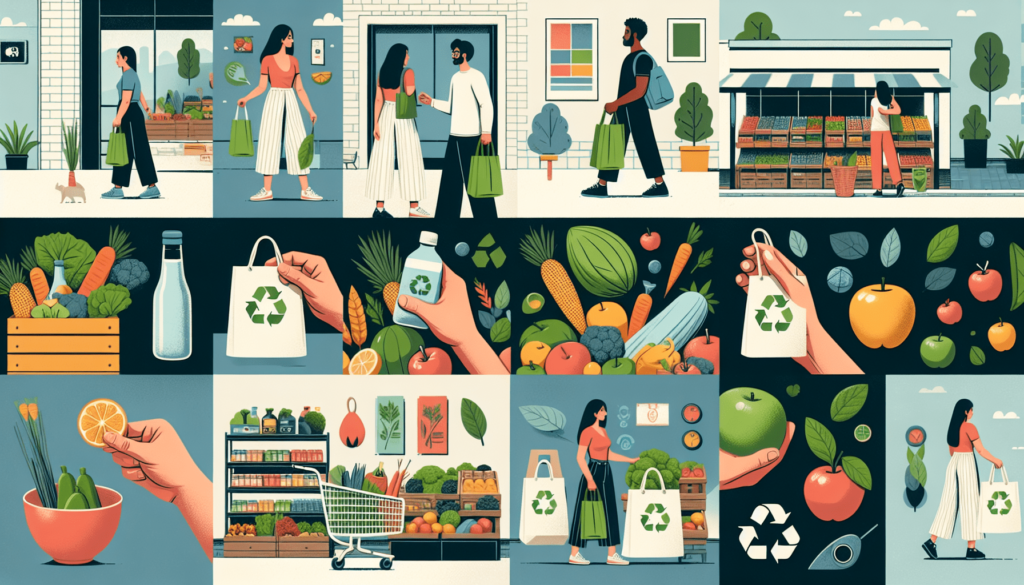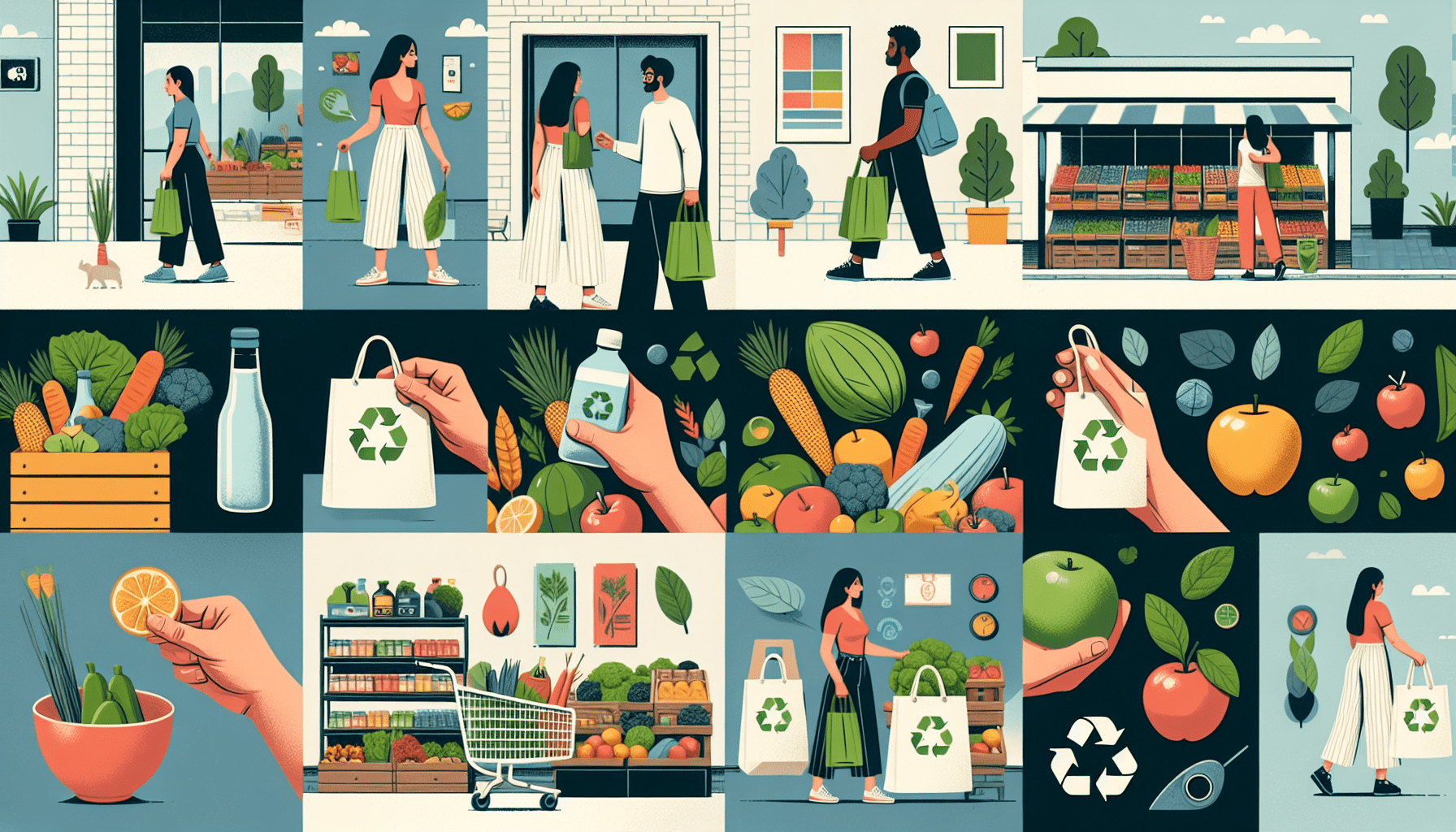Are you interested in making a positive impact on the environment? In this article, you will discover practical tips on how to reduce your carbon footprint while shopping. With simple adjustments to your shopping habits, you can contribute to a healthier planet. Let’s explore easy and effective ways for you to shop sustainably and make a difference.

Choose Sustainable Brands
When it comes to shopping, one of the best ways to reduce your carbon footprint is to choose sustainable brands. These brands prioritize environmental stewardship and social responsibility, making conscious efforts to minimize their impact on the planet. When researching eco-friendly brands, look for those that prioritize sustainable practices throughout their supply chain, from sourcing materials to manufacturing and packaging. These brands often have a strong commitment to reducing waste, conserving energy, and using renewable resources.
To ensure that a brand is truly sustainable, look for certifications and labels that indicate their commitment to environmental and social standards. For example, you can look for certifications such as Fair Trade, B Corp, or Organic. These certifications provide assurance that the brand follows strict guidelines and is dedicated to ethical and sustainable business practices. By supporting brands with these certifications, you are not only reducing your carbon footprint but also contributing to a more just and sustainable global economy.
Reduce Packaging Waste
Packaging waste is a significant contributor to carbon emissions and landfill waste. One of the simplest and most effective ways to reduce packaging waste is to bring your own reusable bags when you go shopping. By doing so, you can avoid using single-use plastic or paper bags provided by the store. Many eco-conscious consumers also bring their own reusable produce bags and bulk bags to further reduce waste.
Another way to reduce packaging waste is to opt for products with minimal packaging. When choosing between two similar products, opt for the one with less excessive packaging. Additionally, it’s essential to avoid single-use items such as disposable water bottles, straws, and utensils. Instead, invest in reusable alternatives that can be used multiple times. Look for stores that offer bulk refill stations for products like cleaning supplies and personal care items. This way, you can reuse your containers and avoid purchasing products in single-use packages altogether.
Shop Local
Shopping local has several benefits, both for the environment and the community. By supporting local businesses, you can reduce transportation emissions associated with long-distance shipping and promote a more sustainable economy. Shopping at local farmers markets and independent stores allows you to buy seasonal and locally produced goods, which often have a lower carbon footprint compared to imported products. When you buy locally, you also have the opportunity to connect with the community and the people behind the products, fostering a sense of connection and trust.
Choose Energy-Efficient Products
Using energy-efficient products is an excellent way to reduce your carbon footprint and save on energy costs. When shopping for appliances, electronics, or lighting solutions, look for the Energy Star label. Energy Star is a program that certifies products as being energy-efficient, ensuring that they consume less energy and produce fewer greenhouse gas emissions. By choosing Energy Star products, you can significantly contribute to reducing carbon emissions while still enjoying the convenience of modern technology.
When it comes to lighting, opt for LED or CFL (compact fluorescent lamp) light bulbs instead of traditional incandescent ones. LED and CFL bulbs use significantly less energy and have a longer lifespan, reducing the frequency of replacements. Additionally, they produce less heat and are more environmentally friendly to dispose of.

Buy Secondhand
Buying secondhand not only helps you save money but also reduces the environmental impact of new product manufacturing. Thrift stores and consignment shops are excellent places to find unique and quality items at a fraction of the cost. By giving these pre-loved items a second life, you can contribute to reducing waste and conserving resources.
Online marketplaces dedicated to selling used goods, such as eBay or Craigslist, provide another avenue for finding secondhand items. These platforms allow you to find specific products and connect with individuals looking to sell their unwanted items. By purchasing from these online marketplaces, you can reduce the demand for new products, ultimately reducing carbon emissions associated with the manufacturing and transportation processes.
It’s equally important to donate and recycle unwanted items rather than simply throwing them away. By donating usable items, you give them a chance to be reused by someone else, further extending their lifecycle. For items that are no longer usable, recycling is the best option to ensure that the materials are repurposed rather than ending up in landfills.
Consider the Lifecycle of Products
When shopping, it’s essential to consider the lifecycle of the products you are purchasing. Choose products made from recycled materials whenever possible. This promotes the demand for recycled materials, which helps reduce the carbon emissions associated with the production of new materials. Many sustainable brands now offer products made from recycled plastics, metals, and fibers, providing quality and eco-friendly options.
Opt for durable and long-lasting items rather than those designed to be disposable. By choosing products with longevity, you reduce the need for frequent replacements, saving resources and reducing waste. Additionally, look for products that are easily repairable or recyclable. Items that can be easily repaired extend their lifespan, while products that can be recycled avoid contributing to landfill waste.
Reduce Food Waste
Food waste is a major contributor to carbon emissions. When food decomposes in landfills, it releases methane, a potent greenhouse gas. To reduce food waste, it’s important to plan meals and make a shopping list before heading to the store. By knowing exactly what you need, you can avoid overbuying and prevent food from going to waste. Be mindful of expiration dates and prioritize using ingredients before they spoil.
Properly storing and preserving perishable items can also help reduce food waste. Learn the best ways to store fruits, vegetables, and other perishables to maintain their freshness for as long as possible. Freezing excess food or using preservation techniques like canning or pickling can extend the shelf life of ingredients, allowing you to use them even after their peak freshness.
For unavoidable food scraps and leftovers that cannot be consumed, composting is an excellent solution. Composting converts organic waste into nutrient-rich soil, which can be used in gardens or for landscaping purposes. By composting, you not only reduce methane emissions from landfills but also create a valuable resource for sustainable gardening.
Use Public Transportation or Carpool
Transportation emissions are a significant contributor to carbon emissions. To reduce your carbon footprint while shopping, consider using public transportation whenever possible. Public transportation systems, such as buses or trains, are generally more fuel-efficient compared to individual cars, as they transport multiple people at once. By utilizing public transportation, you can reduce the number of vehicles on the road and contribute to cleaner air and reduced traffic congestion.
If public transportation is not feasible, carpooling with others is another excellent option. Carpooling allows multiple people to share the same vehicle, reducing the total number of cars on the road and decreasing carbon emissions per person. You can organize carpooling arrangements with friends, neighbors, or colleagues who live nearby or are headed in the same direction. Combining shopping trips with others is a practical solution that reduces the environmental impact of individual transportation.
Avoid Fast Fashion
Fast fashion, characterized by cheap and disposable clothing produced with little regard for the environment or worker rights, has a significant carbon footprint. By choosing quality over quantity, you can avoid contributing to the harmful effects of fast fashion. Invest in timeless fashion pieces made from sustainable materials and produced by ethical brands. These items tend to be more durable, ensuring that they will last for years rather than a few wears.
For special occasions or one-time events, consider renting or borrowing clothes instead of buying new ones. Renting allows you to enjoy luxurious outfits without the need for long-term ownership. Borrowing from friends or family members not only expands your wardrobe options but also strengthens social connections and reduces the need for new garments.
Offset Your Carbon Emissions
Even with conscious shopping choices, it’s difficult to completely eliminate your carbon footprint. However, you can take steps to offset the remaining emissions. Start by calculating your carbon footprint, which measures your individual impact on the environment based on factors such as energy consumption, transportation habits, and waste generation. Various online calculators can help you determine your carbon footprint and identify areas where you can further reduce emissions.
Supporting carbon offset projects is another way to offset your carbon emissions. Carbon offset projects invest in activities that reduce or remove greenhouse gas emissions from the atmosphere, such as reforestation, renewable energy projects, or methane capture projects. By funding these initiatives, you can contribute to balancing out your emissions and supporting sustainable solutions on a larger scale.
Investing in renewable energy projects is another effective way to offset your carbon emissions. Consider purchasing renewable energy certificates (RECs) or supporting community solar projects. These initiatives directly support the expansion of renewable energy sources, driving the transition away from fossil fuels and reducing carbon emissions.
By following these tips and making conscious choices while shopping, you can significantly reduce your carbon footprint and contribute to a more sustainable future. Each individual effort adds up, and together, we can make a positive impact on the health of our planet. So remember, choose sustainable brands, reduce packaging waste, shop local, choose energy-efficient products, buy secondhand, consider the lifecycle of products, reduce food waste, use public transportation or carpool, avoid fast fashion, and offset your carbon emissions. Happy shopping!

